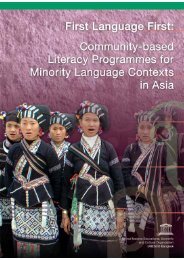Part II.pdf - MTB-MLE Network
Part II.pdf - MTB-MLE Network
Part II.pdf - MTB-MLE Network
Create successful ePaper yourself
Turn your PDF publications into a flip-book with our unique Google optimized e-Paper software.
China<br />
Bilingual Literacy Project for the Lahu Ethnic Minority in Lancang<br />
County, Yunnan Province, China<br />
Dr. Liu Yibing & Mr. Zhao Yuchi 1<br />
As we know, the mother tongue is key to effective basic education, and education in the mother<br />
tongue is one of the best tools for preservation of the culture of ethnolinguistic minority groups.<br />
Using the mother tongue for early education is an effective strategy that contributes to eradication<br />
of illiteracy, ignorance, discrimination and poverty. It can also be a catalyst towards the development<br />
of unity and national identity.<br />
1. Policies on Ethnic Languages in China<br />
In China, there are 56 nationalities with 61 languages, of which there are 39 written languages.<br />
Thus, China’s nationality distribution creates a complex bilingual society and multilingual population.<br />
China’s Constitution and National Law for Language points out that “every nationality has the freedom<br />
to use and develop their own language.” The Law for Ethnic Autonomy states “schools which<br />
mainly enrol students of ethnic groups ought to use text books in their own language if it is possible.<br />
The teaching should be done in the ethnic language. In the upper grades of primary school and<br />
middle school, they should have a bilingual curriculum and popularize Mandarin.”<br />
In the field of adult literary education, Item 6 in Regulations for Illiteracy Eradication issued by<br />
the State Council of the People’s Republic of China (P.R.C.) notes “Mandarin ought to be used for<br />
literacy teaching. In ethnic group regions, the local ethnic language is allowed as the language of<br />
instruction or one of the local ethnic languages should be chosen for literacy teaching.” Also, it<br />
prescribes that “in the places where people use ethnic language as the language for literacy teaching,<br />
the illiteracy eradication criteria will be constructed by the provincial or Regional governments.”<br />
2. Bilingual Literacy for Ethnic Groups in China<br />
The Chinese government has a supportive approach towards bilingual education for ethnolinguistic<br />
groups in minority regions in China. However, there is inequity in the development of opportunities<br />
for different ethnic groups and in different regions.<br />
Generally, in formal education, bilingual education for ethnic groups has been given attention and<br />
financial support. In non-formal adult literacy education, however, it has not received the necessary<br />
support in order to ensure the implementation of bilingual literacy approaches. In formal education,<br />
bilingual teaching for ethnic groups refers to teaching in the ethnic language and Chinese, including<br />
teaching with the use of the mother tongue as a supportive tool. Bilingual teaching in ethnic<br />
community areas mainly includes three types:<br />
1<br />
Research and Training Centre for Literacy Education, Southwest China Normal University, Beibei, Chongqing.<br />
153
















